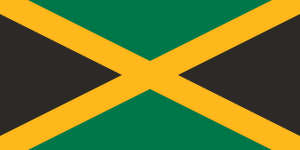
| Colors | HEX Code | RGB | CMYK |
|---|---|---|---|
| Green | #046D45 | 4, 109, 69 | 96, 0, 37, 57 |
| Gold | #FFB81C | 255, 184, 28 | 0, 28, 89, 0 |
| Black | #2D2926 | 45, 41, 38 | 0, 9, 16, 82 |
The flag of Jamaica has a golden saltire that divides the flag into four triangles. The upper and lower triangles are colored green, while the two triangles at the hoist and fly side are black.
Meaning of the Jamaican Flag
The black color depicts the strength and creativity of the Jamaicans. The gold signifies the natural wealth and beauty of sunlight, and the green symbolizes hope and agricultural resources.
History of the Jamaican Flag
Jamaica is an island in the Caribbean Sea that was ruled by Britain. In the early 20th century, Jamaica, like many other British colonies, saw a rise in nationalist movements advocating for self-governance and independence. As Jamaica was preparing for independence, the search for a flag design was launched. The House of Representatives called for proposals to choose the best flag design, but none of the designs presented was accepted. Eventually, a bipartisan committee of the Jamaica House of Representatives ended up designing the flag. The original design included horizontal stripes. However, due to its resemblance to another country’s flag (Tanganyika, which is now a part of Tanzania.) Then, the saltire was chosen to replace the horizontal stripes, although the saltire did not have any significance as a symbol. Jamaica proclaimed its independence on August 6, 1962, and the flag was officially hoisted, symbolizing the nation’s established sovereignty. The flag of Jamaica has not changed since it was officially adopted.